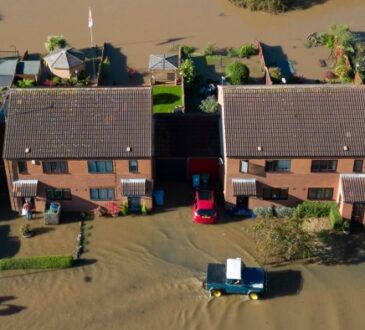
The April data shows:
-
on average, house prices have risen 0.3% since March 2024
-
there has been an annual price rise of 1.1% which makes the average property in the UK valued at £281,000
England
In England the April data shows, on average, house prices have risen by 0.3% since March 2024. The annual price rise of 0.6% takes the average property value to £298,000.
The regional data for England indicates that:
- the South East experienced the most significant monthly increase with a movement of 1.4%
- Yorkshire and the Humber saw the greatest monthly price fall, with a fall of -1.4%
- the South West experienced the greatest annual price rise, up by 1.8%
- London saw the lowest annual price growth, with a fall of -3.9%
Price change by region for England
| Region | Average price Apr 2024 | Annual change % since Apr 2023 | Monthly change % since Mar 2024 |
|---|---|---|---|
| East Midlands | £242,000 | 1.1 | 0.7 |
| East of England | £335,000 | 0.4 | -0.7 |
| London | £502,000 | -3.9 | -0.2 |
| North East | £158,000 | 1.0 | 0.6 |
| North West | £217,000 | 3.8 | 0.7 |
| South East | £375,000 | -0.4 | 1.4 |
| South West | £318,000 | 1.8 | 1.1 |
| West Midlands | £246,000 | 2.0 | 0.4 |
| Yorkshire and the Humber | £203,000 | 0.2 | -1.4 |
Repossession sales by volume for England
The lowest number of repossession sales in February 2024 was in the East of England.
The highest number of repossession sales in February 2024 was in the South East.
| Repossession sales | Feb 2024 |
|---|---|
| East Midlands | 4 |
| East of England | 0 |
| London | 7 |
| North East | 10 |
| North West | 8 |
| South East | 12 |
| South West | 2 |
| West Midlands | 5 |
| Yorkshire and the Humber | 11 |
| England | 59 |
Average price by property type for England
| Property type | Apr 2024 | Apr 2023 | Difference % |
|---|---|---|---|
| Detached | £454,000 | £455,000 | -0.3 |
| Semi-detached | £289,000 | £284,000 | 1.9 |
| Terraced | £246,000 | £243,000 | 1.2 |
| Flat/maisonette | £248,000 | £250,000 | -1.2 |
| All | £298,000 | £296,000 | 0.6 |
Funding and buyer status for England
| Transaction type | Average price Apr 2024 | Annual price change % since Apr 2023 | Monthly price change % since Mar 2024 |
|---|---|---|---|
| Cash | £279,000 | 0.0 | 0.1 |
| Mortgage | £308,000 | 0.9 | 0.5 |
| First-time buyer | £250,000 | 0.9 | 0.6 |
| Former owner occupier | £339,000 | 0.3 | 0.1 |
Building status for England
| Building status* | Average price Jan 2024 | Annual price change % since Jan 2023 | Monthly price change % since Dec 2023 |
|---|---|---|---|
| New build | £420,000 | 14.4 | 10.5 |
| Existing resold property | £293,000 | -2.0 | -0.2 |
*Figures for the 2 most recent months are not being published because there are not enough new build transactions to give a meaningful result.
London
London shows, on average, house prices fell by 0.2% since March 2024. An annual price fall of 3.9% takes the average property value to £502,000.
Average price by property type for London
| Property type | Apr 2024 | Apr 2023 | Difference % |
|---|---|---|---|
| Detached | £966,000 | £1,046,000 | -7.6 |
| Semi-detached | £644,000 | £669,000 | -3.7 |
| Terraced | £544,000 | £564,000 | -3.7 |
| Flat/maisonette | £422,000 | £439,000 | -3.9 |
| All | £502,000 | £522,000 | -3.9 |
Funding and buyer status for London
| Transaction type | Average price Apr 2024 | Annual price change % since Apr 2023 | Monthly price change % since Mar 2024 |
|---|---|---|---|
| Cash | £517,000 | -4.9 | 0.7 |
| Mortgage | £496,000 | -3.7 | -0.4 |
| First-time buyer | £435,000 | -3.7 | 0.0 |
| Former owner occupier | £573,000 | -4.3 | -0.3 |
Building status for London
| Building status* | Average price Feb 2024 | Annual price change % since Feb 2023 | Monthly price change % since Jan 2024 |
|---|---|---|---|
| New build | £567,000 | 8.3 | 9.5 |
| Existing resold property | £509,000 | -4.5 | -0.8 |
*Figures for the 2 most recent months are not being published because there are not enough new build transactions to give a meaningful result.
Wales
Wales shows, on average, house prices fell by 2.1% since March 2024. An annual price increase of 0.4% takes the average property value to £208,000.
There were 4 repossession sales for Wales in February 2024.
Average price by property type for Wales
| Property type | Apr 2024 | Apr 2023 | Difference % |
|---|---|---|---|
| Detached | £310,000 | £313,000 | -1.0 |
| Semi-detached | £204,000 | £202,000 | 0.6 |
| Terraced | £164,000 | £162,000 | 1.1 |
| Flat/maisonette | £137,000 | £136,000 | 0.7 |
| All | £208,000 | £207,000 | 0.4 |
Funding and buyer status for Wales
| Transaction type | Average price Apr 2024 | Annual price change % since Apr 2023 | Monthly price change % since Mar 2024 |
|---|---|---|---|
| Cash | £202,000 | 0.5 | -2.2 |
| Mortgage | £212,000 | 0.3 | -2.1 |
| First-time buyer | £180,000 | 0.7 | -1.9 |
| Former owner occupier | £240,000 | 0.0 | -2.4 |
Building status for Wales
| Building status* | Average price Feb 2024 | Annual price change % since Feb 2023 | Monthly price change % since Jan 2024 |
|---|---|---|---|
| New build | £317,000 | 13.7 | 12.5 |
| Existing resold property | £208,000 | -1.1 | 1.3 |
*Figures for the 2 most recent months are not being published because there are not enough new build transactions to give a meaningful result.
UK house prices
UK house prices rose by 1.1% in the year to April 2024, compared with an increase of 0.9% in the 12 months to March 2024. On a non-seasonally adjusted basis, average house prices in the UK increased by 0.3% between March 2024 and April 2024, compared with a increase of 0.1% during the same period a year earlier (March and April 2023).
The UK Property Transactions Statistics showed that in April 2024, on a seasonally adjusted basis, the estimated number of transactions of residential properties with a value of £40,000 or greater was 90,000. This is 9.8% higher than a year ago (April 2023). Between March 2024 and April 2024, UK transactions increased by 4.6% on a seasonally adjusted basis.
House price monthly increase was highest in the South East where prices increased by 1.4% in the year to April 2024. The highest annual growth was in the the North West, where prices increased by 3.8% in the year to April 2024.
See the economic statement.
The UK HPI is based on completed housing transactions. Typically, a house purchase can take 6 to 8 weeks to reach completion. As with other indicators in the housing market, which typically fluctuate from month to month, it is important not to put too much weight on one month’s set of house price data.
Background
-
We publish the UK House Price Index (HPI) on the second or third Wednesday of each month with Northern Ireland figures updated quarterly. We will publish the May 2024 UK HPI at 9:30am on Wednesday 17 July 2024. See calendar of release dates.
-
We have made some changes to improve the accuracy of the UK HPI. We are not publishing average price and percentage change for new builds and existing resold property as done previously because there are not currently enough new build transactions to provide a reliable result. This means that in this month’s UK HPI reports, new builds and existing resold property are reported in line with the sales volumes currently available.
-
The UK HPI revision period has been extended to 13 months, following a review of the revision policy (see calculating the UK HPI section 4.4). This ensures the data used is more comprehensive.
-
Sales volume data is available by property status (new build and existing property) and funding status (cash and mortgage) in our downloadable data tables. Transactions that require us to create a new register, such as new builds, are more complex and require more time to process. Read revisions to the UK HPI data.
-
Revision tables are available for England and Wales within the downloadable data in CSV format. See about the UK HPI for more information.
-
HM Land Registry, Registers of Scotland, Land & Property Services/Northern Ireland Statistics and Research Agency and the Valuation Office Agency supply data for the UK HPI.
-
The Office for National Statistics (ONS) and Land & Property Services/Northern Ireland Statistics and Research Agency calculate the UK HPI. It applies a hedonic regression model that uses the various sources of data on property price, including HM Land Registry’s Price Paid Dataset, and attributes to produce estimates of the change in house prices each month. Find out more about the methodology used from the ONS and Northern Ireland Statistics & Research Agency.
-
We take the UK Property Transaction statistics from the HM Revenue and Customs (HMRC) monthly estimates of the number of residential and non-residential property transactions in the UK and its constituent countries. The number of property transactions in the UK is highly seasonal, with more activity in the summer months and less in the winter. This regular annual pattern can sometimes mask the underlying movements and trends in the data series. HMRC presents the UK aggregate transaction figures on a seasonally adjusted basis. We make adjustments for both the time of year and the construction of the calendar, including corrections for the position of Easter and the number of trading days in a particular month.
-
UK HPI seasonally adjusted series are calculated at regional and national levels only. See data tables.
-
The first estimate for new build average price (April 2016 report) was based on a small sample which can cause volatility. A three-month moving average has been applied to the latest estimate to remove some of this volatility.
-
The UK HPI reflects the final transaction price for sales of residential property. Using the geometric mean, it covers purchases at market value for owner-occupation and buy-to-let, excluding those purchases not at market value (such as re-mortgages), where the ‘price’ represents a valuation.
-
HM Land Registry provides information on residential property transactions for England and Wales, collected as part of the official registration process for properties that are sold for full market value.
-
The HM Land Registry dataset contains the sale price of the property, the date when the sale was completed, full address details, the type of property (detached, semi-detached, terraced or flat), if it is a newly built property or an established residential building and a variable to indicate if the property has been purchased as a financed transaction (using a mortgage) or as a non-financed transaction (cash purchase).
-
Repossession sales data is based on the number of transactions lodged with HM Land Registry by lenders exercising their power of sale.
-
For England, we show repossession sales volume recorded by government office region. For Wales, we provide repossession sales volume for the number of repossession sales.
-
Repossession sales data is available from April 2016 in CSV format. Find out more information about repossession sales.
-
We publish CSV files of the raw and cleansed aggregated data every month for England, Scotland and Wales. We publish Northern Ireland data on a quarterly basis. They are available for free use and re-use under the Open Government Licence.
-
HM Land Registry’s purpose is to guarantee and protect property rights in England and Wales.
-
HM Land Registry is a government department created in 1862. Its vision is “A world-leading property market as part of a thriving economy and a sustainable future.”
-
HM Land Registry safeguards land and property ownership valued at £8 trillion, enabling over £1 trillion worth of personal and commercial lending to be secured against property across England and Wales. The Land Register contains more than 26 million titles showing evidence of ownership for more than 88% of the land mass of England and Wales.
-
For further information about HM Land Registry visit www.gov.uk/land-registry.
-
Follow us on @HMLandRegistry, our blog, LinkedIn and Facebook.




